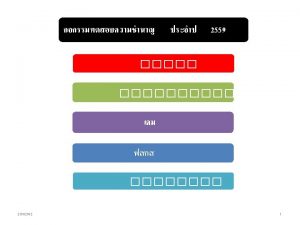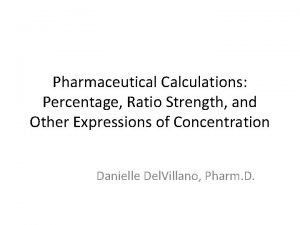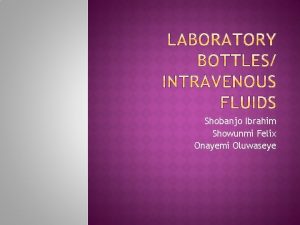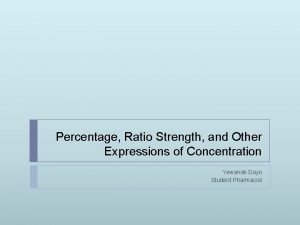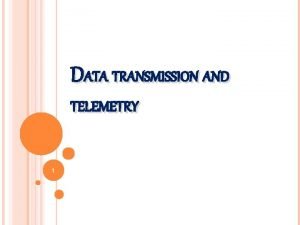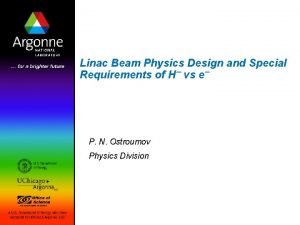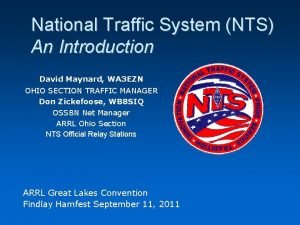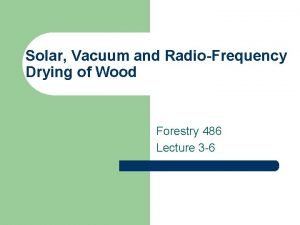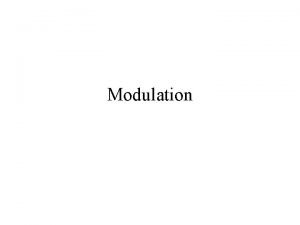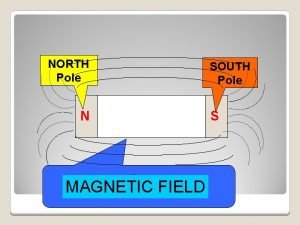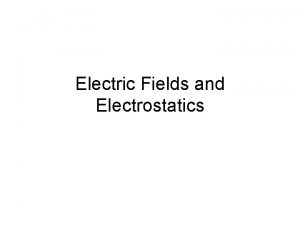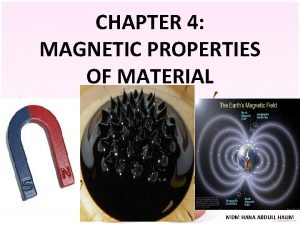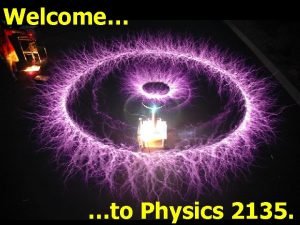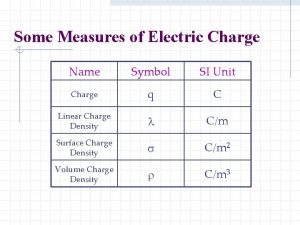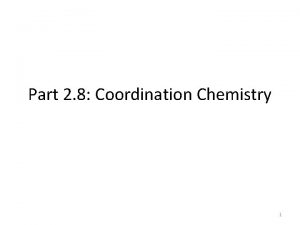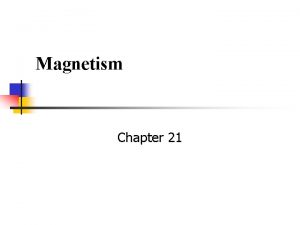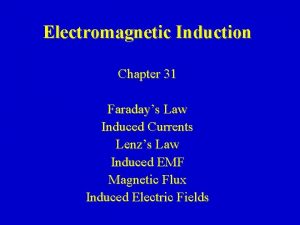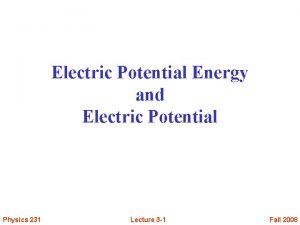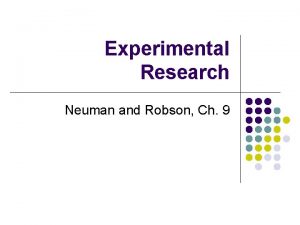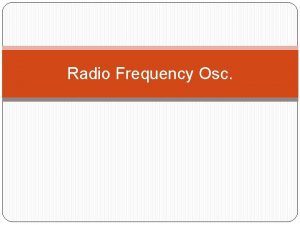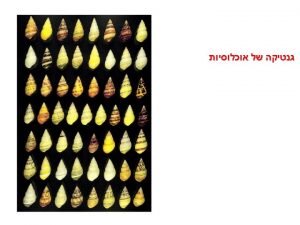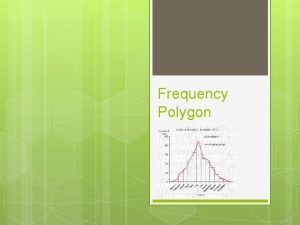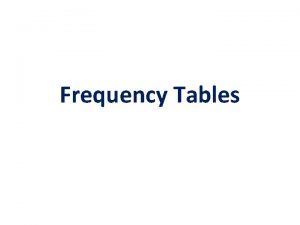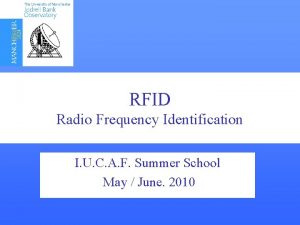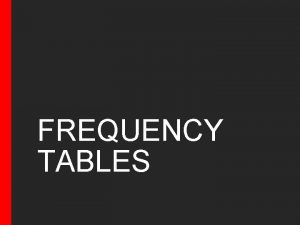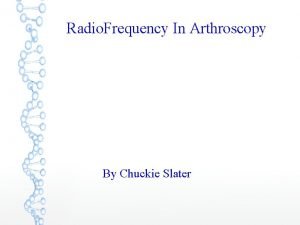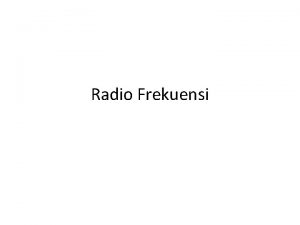Experiment 1 Field strength of radio frequency field













































- Slides: 45

Experiment 1 • Field strength of radio frequency field in Hz: This is the frequency at which the z-magnetization is rotated off the z-axis during application of the pulse Frequency is the inverse of the rotation time. frequency ν is revolutions per seconds. Angular frequency ω is radians per second One rotation equals 2 π rad.

2. 2 How could one confirm that the measured value is indeed the 180 pulse and not a 360 pulse ? In Both cases a zero signal should be observed. • Cutting p 1 in half should give maximum signal (90 pulse). If 360 pulse was measured, cutting p 1 in half will result in zero signal (180 pulse). • Approaching and then overshooting a 180 pulse in small increments will have signal changing from positive to negative. For an 360 pulse the behavior will be from negative to positive. • 2. 3 From the length of the pulse, what is the field strength of the radio frequency field in units of Hz and T, respectively ? • from τP 90 the frequency of rotation about B 1 can be obtained: ν 1 = 1/(4 AτP 90); for τP 90 = 8. 65 A 10 -6 s one obtains 28. 9 k. Hz • conversion to tesla: use ω = γ B and ω= 2π ν B 1 = 2π ν 1/γH = 2π rad A 28. 9 A 103 s-1 (2. 675 A 108 rad T-1 s-1) B 1 = 6. 788 A 10 -4 T

Chem 781 Part 3: Chemical Shift

Macroscopic shielding (bulk effects): • A diamagnetic sample will decrease the magnetic field in the tube (paramagnetic compounds can cause an increase). This effect is equal throughout sample and just causes a constant shift for all nuclei. • As long only relative shifts are of interest the effect can be neglected except: – need for internal reference (TMS or lock solvent inside sample) – problem with external reference or unlocked samples – macroscopic paramagnetic susceptibility of compounds can be measured by NMR (Evan’s method) – Problems with too little solvent / misadjusted sample height (field changes at solvent/air interphase)

Effect of insufficient solvent in sample

Microscopic (local) shielding: • The interaction of the B 0 field with matter takes place on a microscopic (molecular) scale • The B 0 field is homogeneous on a macroscopic level, but it varies on a microscopic scale throughout the molecule depending on the electron distribution around the molecule Microscopic shift is what makes NMR of interest to chemists (i. e. that is why you are in this lecture)

The reason why chemists got involved in NMR

History and origin of chemical shift • Early NMR spectra were all taken of solids. Due to very small T 2 in solids those spectra had very broad lines and did not exhibit any fine structure. • However, in solution T 2 is normally rather long and sharp lines are observed. The first solution NMR ever taken was a 14 N NMR spectum of 14 NH 4(14 NO 3) saturated in H 2 O (IN-14 = 1): Result: Two lines were observed ωNH 4 • ≠ ωNO 3 It is ω = γ 14 N ∙B 0. As γ 14 N is a constant for each nucleus, the actual field has to be differ at the position of the two N-atoms in the molecule, i. e. each atom experiences a slightly different local field due to shielding from the surrounding electrons: ω = ω0 + Ω = γ Bloc = γ (B 0 - Bshielding) = γ B 0 ( 1 - σ) (3. 1) σ is the shielding constant. • Important for the observed lamor frequency is the local field at the nucleus. The interaction of matter (electrons) with the magnetic field results in a change of the magnetic field inside the sample.

Definition of chemical shift • The shielding constant σ is defined with respect to the “naked” nucleus which is impractical to measure. Therefore frequencies are typically reported relative to a reference compound: TMS (tetramethyl silane) for 1 H, 13 C and 29 Si NMR • This number is normally different from the off resonance frequency Ω as TMS is not in the center of spectrum. The shift frequency of a nucleus will depend on magnetic field: • Δν 0 = ν 0 - ν 0 TMS = γB 0/(2π) (σTMS - σ) • it is therefore convenient to express the chemical shift as a fraction of the main field:

Important relations and conventions of chemical shift • δ is normally a very small dimensionless number and is therefore expressed in parts per million (ppm, 10 -6). δ is independent of the magnetic field. • values of δ correspond to lower shielding and thus higher local field B 0, loc and higher frequency ω0. The axis is normally plotted with δ increasing from right to left Note that for historic reasons a shift to the left (high δ) is called downfield and a shift to the right(low δ) is called upfield.

Typical reference compounds Various reference compounds are used for different nuclei (see also table of nuclei) • 1 H, 13 C, 29 Si TMS (insoluble in water, DSS is used in water samples) • 15 N NH 3(liq) (tyically biochemists) CH 3 NO 2 (often used by organic chemists) • 31 P H 3 PO 4 80% Note that sometimes different standards are in use for the same nucleus, so make sure to check when comparing data from literature !!!

Indirect reference • Often chemical shifts of solvent signals are tabulated and can be used as indirect reference, so no TMS has to be added to 1 H and 13 C spectra. • Many lock solvent shifts are stored in the spectrometer computer, allowing a correct scaling to be available once the sample is locked using the shift of the deuterium signal of the lock solvent (note that 2 D and 1 H have the same chemical shifts). • Careful: δ(H 2 O) depends on the temperature: 4. 78 ppm at 298 K, 5. 018 ppm at 278 K. If your instrument is locked on D 2 O and you change the sample temperature, the lock system will keep the instrument locked at the predefined frequency for D 2 O, and all other signals will appear to shift

Absolute frequency referencing • If no reference compound is available for a nucleus tabulated frequencies can be used to calibrate the chemical shift against the proton frequency of TMS. • These Ξ values have been either measured once using standard compounds or were calculated using the ratio γH / γX and are typically listed as values for a TMS 1 H frequency of 100. 00000 MHz. • Thus an internal reference (solvent signal) can be used to calibrate the spectrum of a different nucleus in the sample without the need for a reference for that nucleus to be present in the sample. Example: You measure a 15 N NMR signal ν 0 = 50. 68306615 MHz and want to know the chemical shift against NH 3(liq). The frequency of TMS in the proton spectrum is 500. 1300000 MHz. Using a Ξ value of 10. 13291444 for 15 N-NH 3(liq) one can calculate the frequency of liq. NH 3 at that spectrometer (note that the number in the handout is using Me. NO 2 ): ν 0 NH 3 = 500. 13 A Ξ / 100. 000 = 50. 67774499 MHz and δ = ν 0 - ν 0 NH 3 / v 0 NH 3 = 105 A 10 -6 = 105 ppm relative to NH 3(liq. )

Internal versus External reference • Ideally the reference compound should be within the sample as the compound measured. In some cases that will not always be practical (For example adding 80% H 3 PO 4). • In those cases the reference compound can be inserted in a capillary inside the sample or the reference spectrum can be acquired separately just prior or just after the sample of interest. • But one has to be aware that for accurate results the difference in bulk solvent susceptibility between the two samples needs to be taken into account. Thus this method should only be used when not deuterated solvent is used and use of other internal reference is impractical.

Structure dependence of magnetic shielding: The shielding constant σ can be broken down into three contributions: σ = σdialocal +σparalocal + σremote • σdialocal : diamagnetic induction of local spherical electron density. Depends only on the ground state electron density. • σparalocal : Contribution of electron orbital angular momentum. The term can be regarded as a correction for deviation from spherical symmetry and includes excited electronic states. It is Negligible for 1 H (high energy 1 s - 2 p gap) , but dominant for most other nuclei with p- or d- electrons. The effect is opposite in sign to σdialocal, and acts deshielding. Hence the name paramagnetic, but note that this has nothing to do unpaired electrons • σremote : effect of other atoms or groups (“ring currents”, dipolar effect), solvent effects. Small in most nuclei, but often dominant for protons

Diamagnetic shielding contribution: • Consider proton (1 H): Directly adjacent electrons are in s orbital (1 s): • Spherical charge distribution: The main field B 0 will induce a diamagnetic ring current of the electrons in the orbital such that the induced field Bdia is opposing the main field (induction law) causing a shielding of B 0 • The shielding depends on the electron density in the orbital: A higher electron density will result in higher shielding.

Diamagnetic shielding and proton chemical shift • Hydrogen has only one electron, and shielding is relatively small, resulting in a fairly small chemical shift range. Heavier nuclei have more electrons, so shielding (and chemical shift ranges) are typically larger. But the electron distribution deviates more from spherical and σparalocal becomes more important.

Diamagnetic shift and structure electro negativity of substituent: CH 3 F CH 3 Cl δ(1 H) 4. 13 2. 84 E (X) 4. 0 3. 0 CH 3 Br 2. 45 2. 8 number of electron withdrawing ligands: CH 4 CH 3 Cl CH 2 Cl 2 δ(1 H) 0. 13 2. 84 5. 32 δ(13 C) -2. 1 25. 6 54. 4 CHCl 3 7. 25 77. 7 CH 3 I 1. 98 2. 5 CH 3 -H 0. 13 2. 1 CCl 4 96. 7 anions are normally highly shielded, cations highly deshielded: metal hydrides M-H CH 3 -Li -2 - -25 - 1. 3 (CH 3)2 C+-H + 5. 06 The electron density on the neighbored carbon atom is directly related to electron density on the hydrogen atom.

But careful when heavy atoms are involved For heavy substituent atoms the shear number of additional electrons can more than compensate for electronegativity effects (heavy atom effect): δC CH 3 X CH 2 X 2 CHX 3 CX 4 X = F 71. 6 111. 2 118. 8 119. 4 X = Cl 25. 6 54. 4 77. 7 96. 7 X = Br 9. 6 21. 6 12. 3 -28. 6 X = I -24 -53. 8 -139. 7 -292. 2

“Paramagnetic” (de)shielding contribution • • This term accounts for non spherical symmetry in case of most non-hydrogen atoms, where p- or d- orbitals are involved in the bonding. Its magnitude describes the influence of orbital angular momentum of the surrounding electrons in a non spherical environment. For hydrogen nuclei this contribution is usually negligible because only s- orbitals are present in hydrogen. But for most other nuclei it plays an important role and is particular important if double/triple bonds are present. In a rough approximation, the paramagnetic shielding of nucleus i depends on the energy gap ΔE between the ground state and the lowest excited state, the average radius of the 2 p electrons (r 2 p) and a bond order tem Qj.

Heavy Atom effect: In the case of doubly bound substituents the paramagnetic shielding term causes a deshielding heavy atom effect: Correlation of electronic excitation ΔE and decreased shielding of carbonyl, thio- and seleno-carbonyl compounds δC = CO 2 124. 2 CS 2 192. 8 CSe 2 209. 9

Shielding by remote fields: Magnetic fields induced from electrons on neigh-boring will also effect the field at the local nucleus. The sign of the effect depends on the relative location of the group with respect to the main field: q = 90º Bloc(H) > B 0 Ds < 0 Dd > 0 q =180º Bloc(H) < B 0 Ds > 0 Dd < 0

Orientation dependence of shielding • • • In a solid crystal, the chemical shift will depend on the orientation of the crystal in a magnetic field. In a powder a broad line pattern representing all orientations of individual micro crystals will be observed (chemical shift anisotropy). In solution, many orientations are interconverted by fast molecular tumbling, and the time average contribution of the orientations along x, y, z is observed: If μind was equal for each orientation (isotropic, spherical group), the average effect in solution would be zero. However, bonds are not spherical, thus the effect of one of the orientations will dominate and result in a shift. Most bonds show strongest μind with the bond ⊥ to B 0 (axial symmetry)

The above anisotropy of the shielding constant does not only apply to σremote, but in similar fashion to σpara. It is just most easily visualized for σremote

Anisotropic effect of single bond example axial versus equatorial protons δHax < δHeq (+σ indicates areas of increased shielding, -σ areas of deshielding) The effect is small in σ-bonds, and often overshadowed by other contributions. But in many cases, tenative assignments of axial vs. equatorial can be made based on shift

Anisotropic effect of π-bonds: C=C double bond δHolefin = 5 -7 ppm Aldehydes δHCHO = 9 -11 ppm (combined effect of anisotropy of CO and electron withdrawing effect) but note alkynes: δHC≡H = 1. 8 ppm (≡C-H in shielding part of cone)

Ring Currents Ring currents are particular strong cases of anisotropy of double bond: • aromatics ( 4 n + 2 e-) protons outside ring strongly deshielded ( 7 - 9 ppm), inside of ring strongly shielded (annulenes) • anti-aromatics (4 n e-) reversed “ring current”: shielded outside, deshielded inside • cyclopropane ring: ring current like benzene, but weaker (no π system). Ring protons are in shielded part of the cone (δ = 0. 22 ppm)


Example cyclo propane Cyclopropane has ring Current like benzene, but hydrogens are not in plane and are shielded

Exchanging Protons (OH, NH): Hydrogen Bonding The chemical shift δ for OH and NH signals can vary very much depending on hydrogen bonding. In general stronger H-bonding will cause more deshielding (larger δ values) The reason is that the hydrogen bond is a highly polar bond with the positive part on the hydrogen end. That is at first counterintuitive when looking at the hydrogen as an electron acceptor. example δH(H 2 O) in different solvents: solvent δ(H 2 O) H 2 O 4. 78 DMSO 3. 3 acetone 2. 5 CDCl 3 1. 4 C 6 D 6 0. 3

Example: HN vs. Ha chemical shift range in folded proteins/peptides

Inter- versus Intramolecular hydrogen bonds intermolecular H-bonds are recognized by concentration- and temperature dependent shifts Ø Application: in proteins solvent exposed amide hydrogens can be identified by temperature dependent shift Ø Also: exchanging protons are very sensitive to charge (acidity -> electron density): R-OH δ/ppm 2 -3 Ph-OH C-OH ∥ O 5 -6 12 -14 >NH O=C-NH-, >NH 2+ | ≈3 ≈8

Empirical Methods of chemical shift prediction • Due to the multitude of contributions to the chemical shielding, calculation of accurate chemical shifts from ab initio is often not feasible. • Therefore empirical methods based on experimental data are important. Often, chemical shifts can be calculated as a sum of contributions from substituents which are tabulated for may common groups. The shift of the unsubstituted fragment is used as a base: Substituted methanes Substituted olefins δ H = δ H base + ∑ Si, H δ Base = 0. 23 ppm δH = δHBase + Sgem + Scis + Strans δHBase = 5. 25 ppm

Example of chemical shift increment calculation + + δA : 5. 25 1. 38 (aryl-gem) 0. 98 (COOH-cis) ──── 7. 61 (7. 82 exp) δB 5. 25 0. 36 (aryl-cis) 0. 80 (COOH-gem) ─── 6. 41 (6. 47 exp) See Handout for tables with proton substituent increments

Chemical shift and symmetry As general rule: If two nuclei can be interconverted by a symmetry operation (mirror, rotation, translation) they are equivalent and will have the same chemical shift

Chemical equivalence and intensity • Groups of chemically equivalent nuclei will have same Lamor frequency. • The intensity (more accurate: integral) of the signal will be proportional to the number of nuclei in each group • Number of distinct signals and their relative integrals are the first piece of information obtained from an NMR spectrum

NMR and Enantiomers • Enantiomers always have identical NMR spectra since they can be interconverted into each other by a symmetry operation (mirror image) • but see recent publications on calculated asymmetries on molecular level due to weak force parity violation Not important for any practical NMR purposes so far

Diastereotopic protons • Protons that can not be interconverted by a symmetry operation will in principle give distinct signals • Chiral centers can cause neighboring pairs of protons or other groups to be inequivalent. The chemical shift difference will decrease with distance from chiral center.

Distinct peaks even in the presence of free rotation • Inequivalency will still hold true for the time average shift in the case of fast rotation of the group in question: • even if the three conformations I, II and III above are equally populated because H 1[I] ≠ H 2[II] etc. However, the chemical shift difference will be smaller than in rigid (ring) systems. Note however methyl groups (R = H): Here fast rotation will result in the same average shift for all protons since H 1[I] = H 2[II] in this case => methyl protons almost always equivalent •

Measurement of enantiomeric excess: • As enantiomers can not be distinguished by NMR, measuring e. e. requires conversion of a mixture of enantiomers into a mixture of diastereomers. Use integration to determine ratio of diastereomers. • • use chiral solvent or solvating agent (shift reagent, may be paramagnetic) make derivative adding a chiral (optically pure) substituent R-product + S-product enantiomers Identical NMR spectra R-reagent ───────> R-R-derivative + R-S-derivative Diastereomers two sets of signals for mixture

Sometimes no chiral reagent is needed Dimerization can also result in formation of diastereomers:

Isotope shifts Note that substitution of a nucleus by another isotope of the same element constitutes a different molecule which can cause a slightly different shift for neighboring nucleus: δH(HCHCl 2) ≠ δH(HCDCl 2) δC(CDCl 3) ≠ δ(CHCl 3)

Consideration of Dynamics • • So far static molecules were considered. Real molecules often undergo rapid conformational rearrangement and rotation about bonds. The NMR spectrum will depend on the exact rate of interconversion between different chemical environments (k. AB) and their chemical shift separation as measured in Hz (Dn. AB) • k. AB ≫ Δv. AB: If the rate of interconversion is much larger than the chemical shift difference measured in Hz between the conformers an weighted average shift is observed. • k. AB ≪ Δv: If the rate is much smaller then separate signals are observed for each conformer.

Examples of very fast or very slow exchange • Cyclohexane has both equatorial and axial protons. But at room temperature only signal is observed in the proton NMR spectrum. At very low temperature, separate signals are observed. • Methyl groups always rotate fast and give rise to one signal of relative intensity of three • Double bonds usually exhibit no rotation, and groups give separate signals unless symmetry is present.

Intermediate exchange regime • • • k. AB ≈ ΔνAB : If the rate is of the same order of magnitude as the chemical shift difference one observes a signal that is intermediate to one sharp average or of several sharp distinct signals Such a signal is very sensitive to k. AB (temperature) and Dn. AB (field strength) and can consist of two broad or one broad average signal. Sometimes, in particular carbon NMR (large Dn, low signal to noise), the signal at its broadest can be obscured in the baseline. Exchange of acidic O-H and N-H protons with each other or water in the sample often causes broadening. Non protic hydrogen bond acceptors like DMSO tend to stabilize such protons and make them more likely to be observed. Other compounds that exhibit internal reorientations on the NMR timescale at room temperature include partial double bonds (for example N, N-dimethylformamide) O CH 3 C N H CH 3 Dddd = A-B
 Steel bar
Steel bar Percentage strength
Percentage strength What is half strength darrow's solution
What is half strength darrow's solution The percentage strength means gram in
The percentage strength means gram in Trunking vs conventional radio system
Trunking vs conventional radio system Telemetry system
Telemetry system Radio frequency quadrupole
Radio frequency quadrupole Mij fm news
Mij fm news Nts radio frequency
Nts radio frequency Radio frequency identification
Radio frequency identification Radio frequency identification
Radio frequency identification Radio frequency vacuum dry kiln
Radio frequency vacuum dry kiln Radio haanji
Radio haanji Fm modulation
Fm modulation Radio frequency design and technology
Radio frequency design and technology Radio frequency antenna
Radio frequency antenna Radio haanji app
Radio haanji app What is a joint relative frequency
What is a joint relative frequency How to calculate relative frequency
How to calculate relative frequency Peak factor formula
Peak factor formula Vmax = aw
Vmax = aw Relative frequency bar chart
Relative frequency bar chart What is a marginal frequency
What is a marginal frequency What is a joint frequency in math
What is a joint frequency in math Magnetising
Magnetising Flux in weber
Flux in weber Electric field unit
Electric field unit Paramagnetic diamagnetic ferromagnetic
Paramagnetic diamagnetic ferromagnetic Strength of the electric field is
Strength of the electric field is Conductors and insulators
Conductors and insulators The unit of electric charge is
The unit of electric charge is Ligand field strength order
Ligand field strength order The laws of gravity
The laws of gravity Magnetic field strength
Magnetic field strength Faraday's law of induction
Faraday's law of induction Electrical force formula
Electrical force formula Electric potential energy work formula
Electric potential energy work formula Definition of potential gradient
Definition of potential gradient Electric field strength
Electric field strength Field experiment
Field experiment Field experimentation
Field experimentation Gauss law of magnetism
Gauss law of magnetism Individual differences factors
Individual differences factors Field dependent vs field independent
Field dependent vs field independent Electric field and magnetic field difference
Electric field and magnetic field difference Waveguide cutoff frequency
Waveguide cutoff frequency
